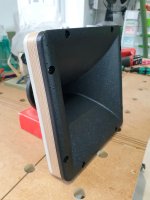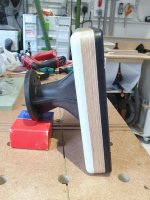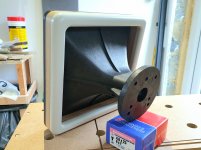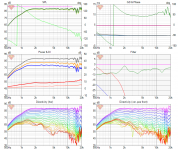A lot of times I mount the driver non flushed in and the cut a 3mm piece of mdf or ply to overlay and glue to the baffle. It's pretty easy to cut 3mm stuff accurately with a jigsaw if you go slow enough. (You can use some thick card as a gasket to bring the tweeter flange out to match)
Cheers,
Rob.
Cheers,
Rob.
What do you guys think about pairing a highly sensitive CD with a woofer around only 90dB?
Does one really lose lots of dynamicism or similar?
Enjoying my Peerless SLS12 at the moment but wonder what could be gained (ignoring amplification for the moment).
Does one really lose lots of dynamicism or similar?
Enjoying my Peerless SLS12 at the moment but wonder what could be gained (ignoring amplification for the moment).
Dynamics is the span between the lowest and highest volumes that a loudspeaker will reproduce without the introduction of errors. Sensitivity of the loudspeaker alone does not say anything about this. If you run the speaker at low volumes, the noise floor will erase many details and the dynamics will be deminished. If it cannot run with high output without failing some or another way, dynamics will be limited. The same highly efficient woofer, limited to different maximum SPL levels, but also powered with different voltage levels, might in this direction or the other be more limited in it's dynamics, while it's sound signature and technical abilities will probably be exactly the same.
The woofer to tweeter sensitivity difference is rarely small, even with small dome tweeters. With my Workshop Bangers the woofer is (on paper) 86db vs 101db for the horn driver. They sound great.
It will be measurable, for sure, in distortion. But, will it be bad or intolerable? Unlikely so long as the filter network is good. I say go for it, what is there to lose if all you need to do is dump a horn and CD on top of your existing cabinets and make a crossover?
It will be measurable, for sure, in distortion. But, will it be bad or intolerable? Unlikely so long as the filter network is good. I say go for it, what is there to lose if all you need to do is dump a horn and CD on top of your existing cabinets and make a crossover?
I thought so too (technically) but wasn´t sure so thanks for a different perspective.
That opens up the choice for 10"-woofers or similar considerably.
I have been simulating for fun mainly and looking at some choices
as I might be going back to a (small ~ 40-60l big bookshelf on stands) enclosure (from OB).
Of the low-sens. kind I like the Dayton RS270, Visaton W250S.
Plus probably many Seas woofers etc.
High sens. I´d be tempted to try a 10FE200 after reading the reviews on ampslab.com. It is cheap and could work in a sealed enclosure.
The Celestion TF1225 (1020), Oberton 10B200 and Monacor SPA-110PA seem quite good for the money too.
Haven´t even started looking at LaVoce woofers. Many good drivers out there!
That opens up the choice for 10"-woofers or similar considerably.
I have been simulating for fun mainly and looking at some choices
as I might be going back to a (small ~ 40-60l big bookshelf on stands) enclosure (from OB).
Of the low-sens. kind I like the Dayton RS270, Visaton W250S.
Plus probably many Seas woofers etc.
High sens. I´d be tempted to try a 10FE200 after reading the reviews on ampslab.com. It is cheap and could work in a sealed enclosure.
The Celestion TF1225 (1020), Oberton 10B200 and Monacor SPA-110PA seem quite good for the money too.
Haven´t even started looking at LaVoce woofers. Many good drivers out there!
Last edited:
A little progress. Perhaps a little presumptuous to make a finished thing for the horn as I havent heard it yet but I want to try a constant directivity horn for a least a couple of months so this takes the industrial object edge off it.
When I did a less fancy version of this for the cast aluminium STH100 horn it deadened all the ring so I can only assume this will help the RCF one in rigidity and give it a bit of mass.
When I did a less fancy version of this for the cast aluminium STH100 horn it deadened all the ring so I can only assume this will help the RCF one in rigidity and give it a bit of mass.
Attachments
Last edited:
Nice, but what type of ringing do you talking about graham? Did you heard ringing with the sth100 that came from the horn when sound was played and the wooden frame has reduced that audible ringing?
No, no measurable ringing (that i can recall) but horns like the STH100 and this one arent meant to be freestanding. When you held the STH100 and tapped it then it would ring for a while but of course it was designed to be coupled to something (a cabinet) which would eliminate this.
If I get the opportunity I will take some near field measurements of the horn with and without the bezel and see if there is anything to note.
If I get the opportunity I will take some near field measurements of the horn with and without the bezel and see if there is anything to note.
Looking very nice. Still, have you considered extending the horn at its outset with round-overs? Diffraction will rip through the response and leave deep traces.
What do you guys think about pairing a highly sensitive CD with a woofer around only 90dB?
Does one really lose lots of dynamicism or similar?
Enjoying my Peerless SLS12 at the moment but wonder what could be gained (ignoring amplification for the moment).
I use compression drivers with home HiFi woofers. It's a combination that works well IMO.
The compression drivers have lower distortion than the woofers, but that's to be expected, with a 20dB difference in sensitivity.
When you consider Hoffman's Iron Law (small, low, efficient - pick any two), I'm happy to use HiFi woofers and get useful LF extension from a domestically acceptable package.
With high-sensitivity drivers often having relatively short Xmax, I suspect I have more LF output this way, too, at the expense of requiring a bigger amplifier.
Chris
Since there is plenty of power available these days for cheap, I think it's more useful to look at maxSPL per woofer as well as Klippel measurements.
Hoffman's "Law" was (is) nice for passive speakers and also back in the old days when power was (very) expensive and inefficient.
That being said, it proves even more the point of splitting the system in two parts.
Were everything below 100-150Hz is being done by subs
(which can be build into the same monitor/enclosure)
It's just so much less a tug of war.
Hoffman's "Law" was (is) nice for passive speakers and also back in the old days when power was (very) expensive and inefficient.
That being said, it proves even more the point of splitting the system in two parts.
Were everything below 100-150Hz is being done by subs
(which can be build into the same monitor/enclosure)
It's just so much less a tug of war.
Might be something to this, especially off axis. grahamgraham would have to measure the response to verify.Looking very nice. Still, have you considered extending the horn at its outset with round-overs? Diffraction will rip through the response and leave deep traces.
^ see post #53, difraction is not too big problem, some around 4kHz and below. Diffraction interference is easiest to identify as overlapping/pinched lines in the normalized polar response. In the ATH thread we have seen roundovers seem to help any waveguide for better looking results, but it might be a lot of work to and not a big improvement to slap on a roundover to a readymade device.
Last edited:
Thanks Chris. Enjoy your posts with regards to "PA" and driver choice very much BTW!I use compression drivers with home HiFi woofers. It's a combination that works well IMO.
I´d be happy to choose a 10" Faital (10PRxxx/10FHxxx) for sensitivity and good off-axis response in the XO-region (1-1.2kHz) but not sure these would provide much bass and/or react well to much higher volume (40l or so) sealed enclosures and Linkwitz transform. (the 10FE200 being an exception but with higher Qts and not that often reviewed for hifi purposes)
I think priority should be to get the midrange, XO-region and dispersion right but it would also be nice to get reasonable bass out of this 2-way. Am not looking for high SPL&deep bass into the 20´s Hz but it would be nice to get by without a sub.
(being restricted to a minidsp 2x4 for the moment)
That said and as B_force mentioned, it would make things much simpler to disregard bass response for the 2-way and add mono/stereo subs.
I could easily make a potent ripole sub out of my two SLS12 drivers which provide very nice bass OB.
Even looking at 8" drivers at the moment which probably would be just fine for my SPL-/bass-needs and yes, hifi-woofers are usually much more capable in the bass department. (Peerless 830869, RS225P, (PM220, JA8008)...)
The problem really is, we got too big a choice😉
^ see post #53, difraction is not too big problem, some around 4kHz and below. Diffraction interference is easiest to identify as overlapping/pinched lines in the normalized polar response. In the ATH thread we have seen roundovers seem to help any waveguide for better looking results, but it might be a lot of work to and not a big improvement to slap on a roundover to a readymade device.
I don't think you are right. 22 cm equals 1.5k, where the peak is and at 2k is the ditch. From 3k on it becomes visible in the normalized plot, the difference between on- and off axis reponse, slowly shifting. It is very simple: at 1.5k, there IS diffraction happening, it must, because there is an open edge. Round-overs, as in baffle edges, and termination, as designed in Ath waveguides, are two similar, but still very different solutions: The latter is an integrated solution for an optimized waveguide, the first is simply following basic insight, how to avoid strongly localized diffraction effects by smearing it through space, and hence, over frequency spectrum. You can do this separately. The simpler solution is but a question of the magnitude of radius. Easily applied and still worthwhile 🙂
If it is diffraction why isn't it changing according to angle as it would be free of the guidance of the horn flare byt this point?
tmuikku, you beat me to it with your summing up. I have used 3 horns and have had no measurements that show this and all 3 were free standing.
H9800 + STH100 with the Peerless DFM-2535R00-08:
System Based Around JBL H9800 Horn
ME10 with the Peerless DFM-2535R00-08:
System Based Around JBL H9800 Horn
However, I don't think throwing around random compression driver and horn combos proves anything of this matter. It is such a shifting target. The peek and trough you speak of, sheeple, may very well be the result of that driver on that horn. It is inconclusive.
tmuikku, you beat me to it with your summing up. I have used 3 horns and have had no measurements that show this and all 3 were free standing.
H9800 + STH100 with the Peerless DFM-2535R00-08:
System Based Around JBL H9800 Horn
ME10 with the Peerless DFM-2535R00-08:
System Based Around JBL H9800 Horn
However, I don't think throwing around random compression driver and horn combos proves anything of this matter. It is such a shifting target. The peek and trough you speak of, sheeple, may very well be the result of that driver on that horn. It is inconclusive.
Last edited:
Did another quick measurement with RCF H100 + HF108 but something still ain´t right. Looks like one of the samples has a defect or so though I still hope it doesn´t! Unscrewed it from the horn and back on but no change to the FR.
Will get back with more measurements when I find the fault (or not..).
Oh forgot: this is with a 24dB-HP-filter (BW) at 800Hz.
How did you get on with this? Did you find a solution?
I don't think you are right. 22 cm equals 1.5k, where the peak is and at 2k is the ditch. From 3k on it becomes visible in the normalized plot, the difference between on- and off axis reponse, slowly shifting. It is very simple: at 1.5k, there IS diffraction happening, it must, because there is an open edge. Round-overs, as in baffle edges, and termination, as designed in Ath waveguides, are two similar, but still very different solutions: The latter is an integrated solution for an optimized waveguide, the first is simply following basic insight, how to avoid strongly localized diffraction effects by smearing it through space, and hence, over frequency spectrum. You can do this separately. The simpler solution is but a question of the magnitude of radius. Easily applied and still worthwhile 🙂
If look at the un normalized graphs the peak and dip is from the driver and can be EQ smooth. Look at the normalized graph which is basically 0 axis EQd flat. The other lines (off-axis angles) are not straight but if look at the scale they go up and down within 1dB, very acceptable result especially with no construction involved.
You are right that roundovers would help but I suspect they would need to be r > ~5cm to smoothen the diffraction at 4kHz and below and still some of the issues might persist, it is a diffraction slot devise after all. Hence there might not be that much of improvement and would be lots of work to build one. If one wants to really better the response one should look for custom made waveguide 🙂
Actually the diffraction is surprisingly low, I expected much worse and it would be if the waveguide was on a baffle, without roundovers. On a flat baffle diffraction is easiest to minimize by reducing the flat are around sound source and I think here is similar situation, only some of the sound goes to the edge, which is very close to the source = not much of a delay = not much of interference problems. Roundovers are little better with very high cost in comparison, there is no work and no cost using the waveguide naked.
Last edited:
edit time over, here is the H100 with HF10AK in application with EQ and xo. As you see it is not perfect, but very acceptable performance. The graphs here are not normalized.
Edit, very rough baffle roundover guestimate attached 😀 Made diffraction sim that showed on axis diffraction peak and dip somewhere around like the H100, peak < 2kHz, dip ~4kHz. Roundovers help some already at 20mm but to smoothen the ~2kHz further bigger roundovers are needed. Even though we have a waveguide and the diffraction simulator is just a flat baffle and transducer I think this still illustrates the roundover needed for ~<4kHz stuff. It is all mostly relative to the wavelengths in question. The attachment cycles through 0, 20mm, 40mm, 60mm roundovers.
Edit, very rough baffle roundover guestimate attached 😀 Made diffraction sim that showed on axis diffraction peak and dip somewhere around like the H100, peak < 2kHz, dip ~4kHz. Roundovers help some already at 20mm but to smoothen the ~2kHz further bigger roundovers are needed. Even though we have a waveguide and the diffraction simulator is just a flat baffle and transducer I think this still illustrates the roundover needed for ~<4kHz stuff. It is all mostly relative to the wavelengths in question. The attachment cycles through 0, 20mm, 40mm, 60mm roundovers.
Attachments
Last edited:
I've got to add that estimating the amount of diffraction vs. other anomalies of a waveguide and how big of a roundover would be good for the response is very difficult and is estimate at best. It would be very nice to see how much roundovers would help the response, if someone is willing to do the work 😀 I think that there is very little to be bettered though, hence posting all of this. Clearly better device would require completely different profile. Also I claimed the off-axis response varies roughly within 1dB when it actually varies roughly within 2dB, +-1dB 😀 Anyway, gotta be happy for the performance / cost ratio. Carry on
Last edited:
- Home
- Loudspeakers
- Multi-Way
- 10" + CD/Horn 2-Way




